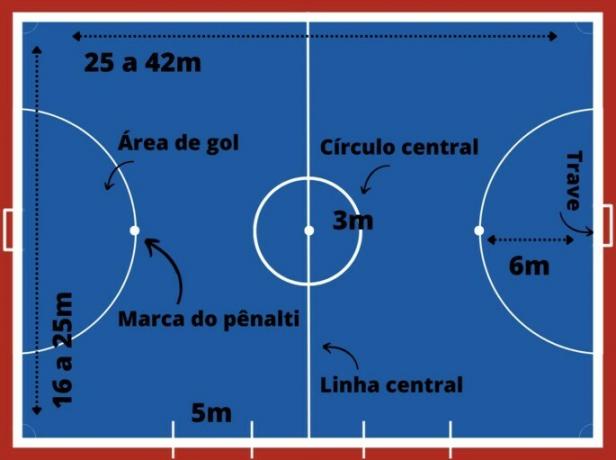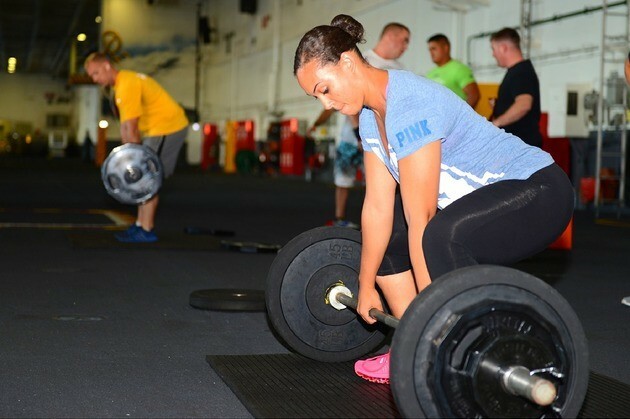Futsal is a team sport. It is a variation of classic football played on one court and with 5 players on each team.
Futsal is also called indoor soccer. This sport is more dynamic and faster than classic football.
The objective of the game is to score goals in the opposing team's goal. The team that has scored the most goals in the game time (2 halves of 20 minutes) will win the match.
Game rules
Despite being a variation of classic football, futsal is considered a distinct sport. Futsal has its own rules and fundamentals:
- THE square is rectangular in shape and can vary between 25 and 42 meters in length, and between 16 and 25 meters in width.
- The ball is between 62 and 64 cm in circumference and weighs from 400 to 440 g. The futsal ball is smaller and heavier than the traditional soccer ball.
- The game is played between two teams. Each team has 5 players on court: the goalkeeper, the wingers (flankers), the fixed (defense/defender) and the pivot (attacker).
- The game has a referee and an assistant.
- A futsal match is divided into two parts of 20 minutes each. The break is 10 minutes.
- At the beginning of the game, a coin toss is drawn between the captains of each team. Whoever wins the toss can choose between kicking off the match or either side of the court.
- After the break, the teams switch sides on the court and the other team takes the first kick.
- The kick-off of the match is taken from the center of the court. The player who starts the game can only touch the ball again after the ball has already been touched by another player.
- After a goal, the ball returns to the center of the court and the team that concedes the goal takes the kick back to the match.
- The team opposite the one taking the restart kick must be on its side of the court, outside the center circle, until the ball is kicked and is "in play".
- No limits on substitutions of players, which can be made at any time during the game in the area, next to the court, intended for substitutions.
- If the game ends in a tie, there is a 10-minute overtime, divided into two 5-minute halves, but without a break. If the tie remains, the game will be decided on penalties.
- A player who misbehaves or breaks the rules may be punished by the referee.
- In futsal, yellow and red cards are also used as a warning and punishment. As in football, when receiving two yellow cards for warning, the player is expelled from the game. The red card automatically leads to expulsion.
- When a player is sent off, he is replaced by another, but only after 2 minutes after the penalized player has left. However, if in that period, the team concedes a goal, the substitute player can enter immediately.
- Each team can make up to five fouls for game time. In the penalties of the first five fouls, the formation of a barrier is allowed. However, when scoring the sixth (and subsequent) fouls, the penalty a will be taken as a direct free kick without barriers.
Futsal court

The futsal court is rectangular in shape. The measurements of the court may vary depending on the competition, whether it is state, national or international. Respecting the rules of the entity that regulates the sport in the region.
The variation can also occur due to the modality, whether the game is under 20 or adult, female or male, among others.
The courts in the international standard are usually the largest: 38 to 42 meters long, and between 20 and 25 meters wide.
Futsal history
There are two versions for the origin of Futsal, one says that the sport arose in Brazil and, the other, in Uruguay. However, sports scholars point out that the Uruguayan version is the true one.
Juan Carlos Ceriani he is considered the father and inventor of the sport. Which he called "Indoor-foot-ball", which means "indoor-football" or "closed-space football".
Ceriani was Argentine and was a Physical Education teacher in Uruguay, at the Christian Association of Young Men in Montevideo, where the sport began to be practiced in 1934.
The teacher thought about football being played on another type of terrain, but also being mixed with rules and fundamentals from other sports, such as basketball and handball.
Find out more about the rules of basketball It's from handball.
In the following years, the sport spread to countries in South America and, little by little, reached other continents.
In 1969, the South American Indoor Soccer Confederation was founded in Asunción, Paraguay. In 1971, in São Paulo, the International Indoor Football Federation (Fifusa).
In 1982, the 1st Indoor Soccer World Championship took place in São Paulo, with the participation of countries from the Americas, Europe and Asia. Brazil was the champion, defeating Paraguay.
In 1989, the International Football Federation (FIFA) began to coordinate the sport internationally.
The other version for the emergence of futsal says that the sport emerged when a group of young people from a Christian association in São Paulo decided to play football inside a basketball court.
Young people could not access a lawn to play the classic version of the sport, having to create an alternative. However, this version is the least accepted.
Futsal in Brazil
Futsal is a famous sport in Brazil. Both in amateur and professional games. Sport is also one of the most practiced and studied in Brazilian schools, in the curriculum of the Physical Education discipline.
Brazil has five world champion titles in the Futsal World Cup, organized by the International Football Federation (FIFA). And two previous titles, when the championship was organized by the International Indoor Soccer Federation (Fifusa).
He was also the first world champion of the sport, in 1982, in the I World Cup of Indoor Soccer, in São Paulo. In all, there are seven world titles, being the biggest champion in the modality.



